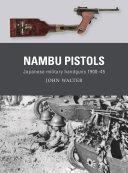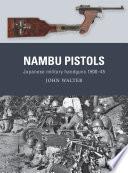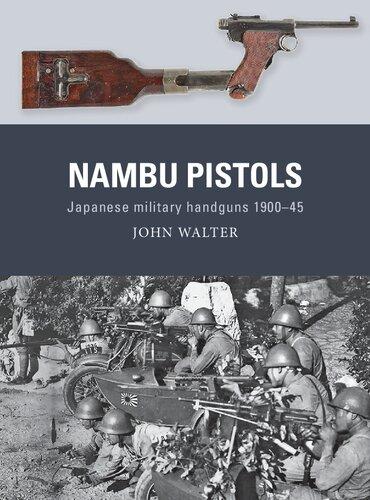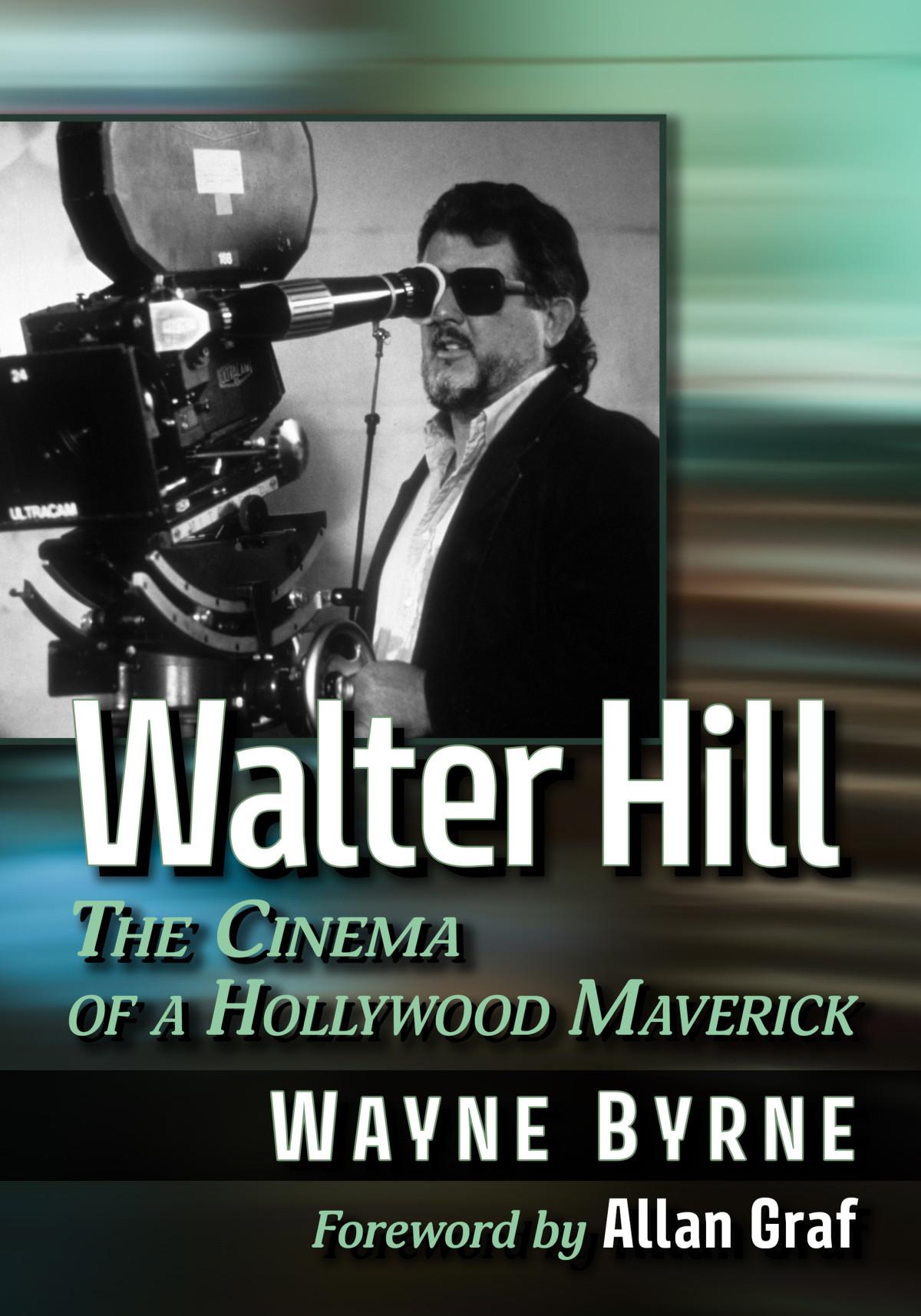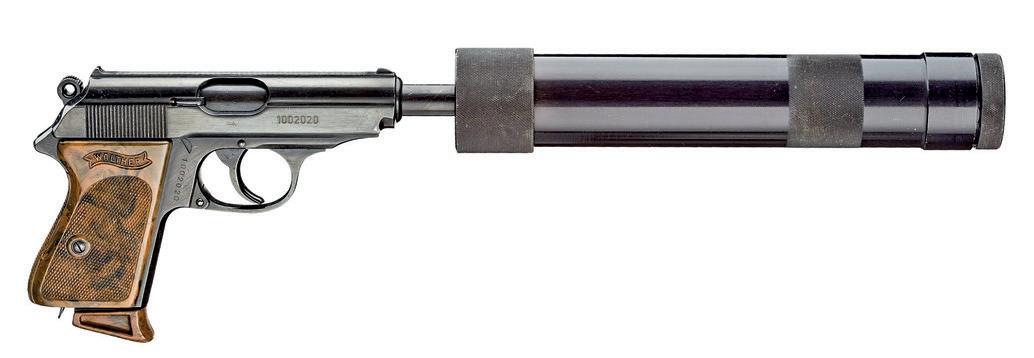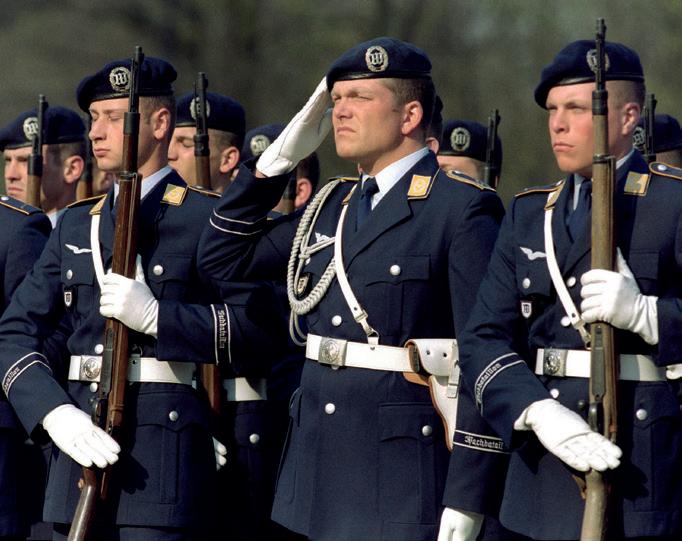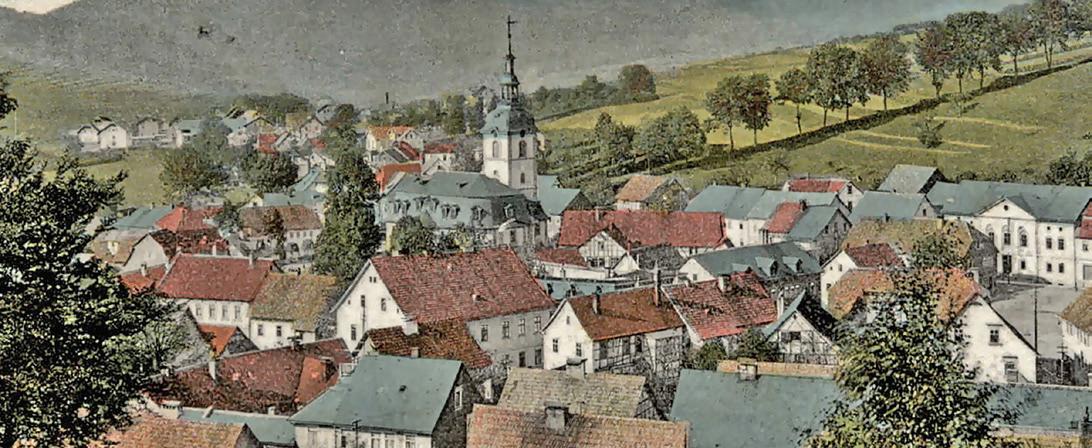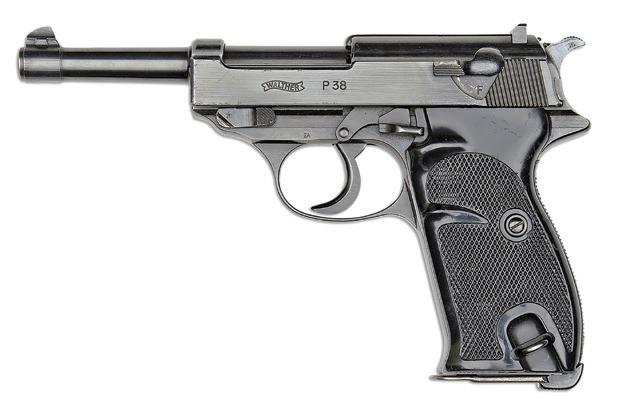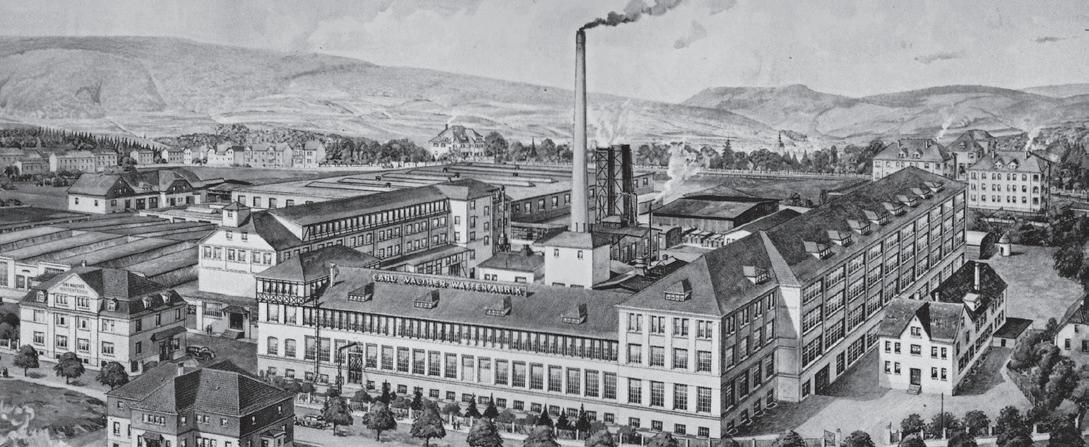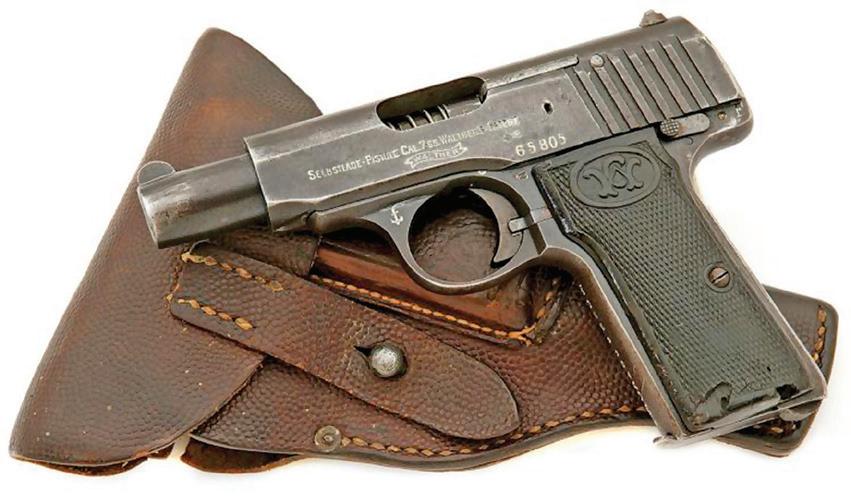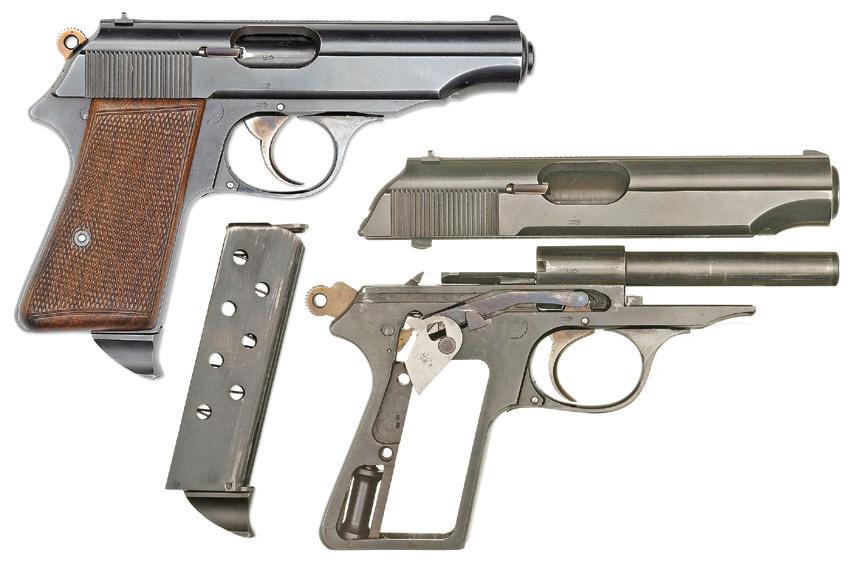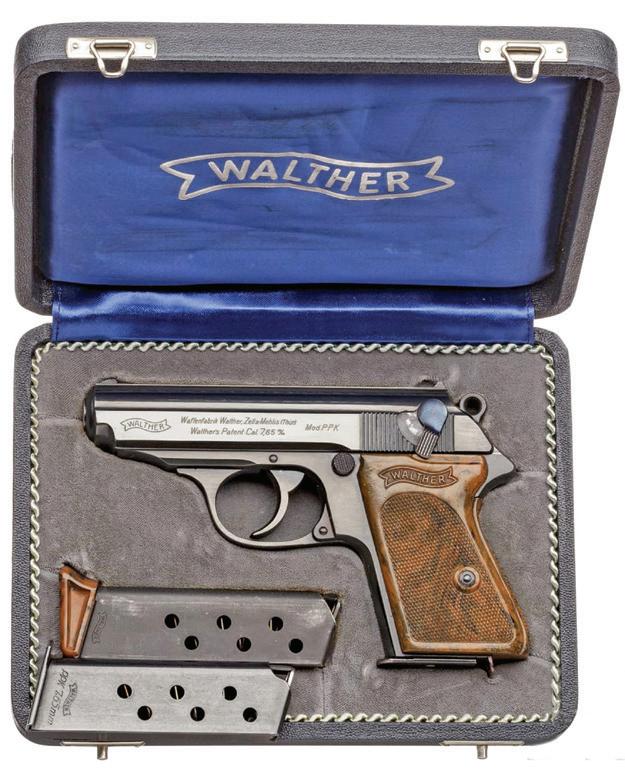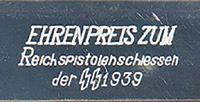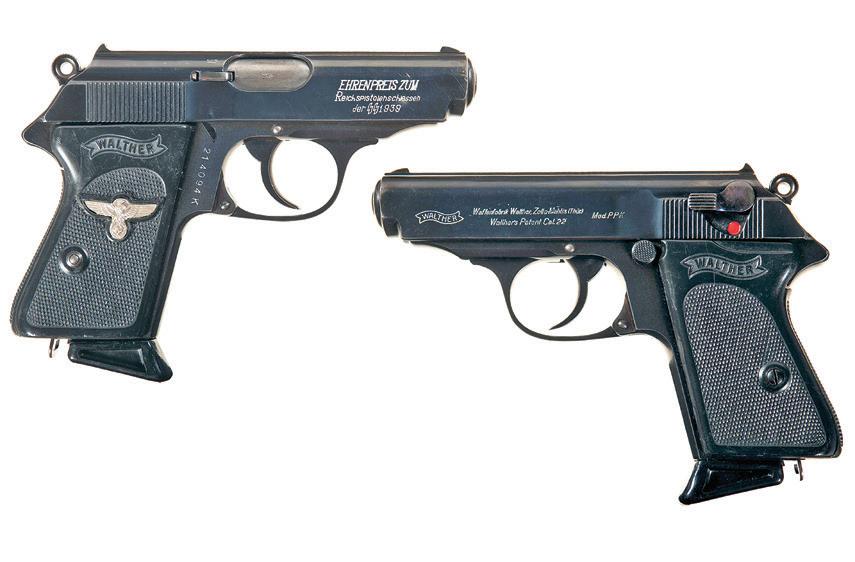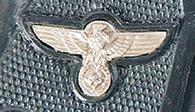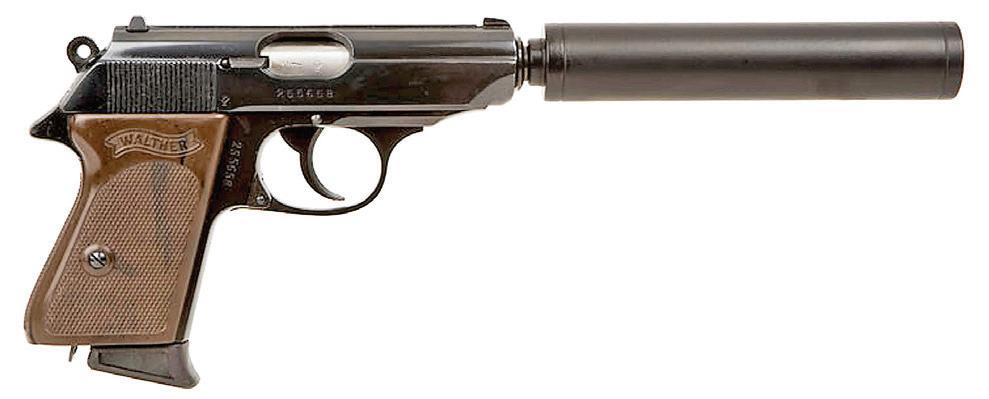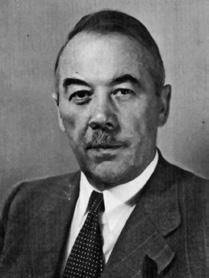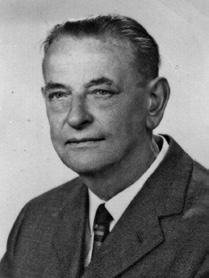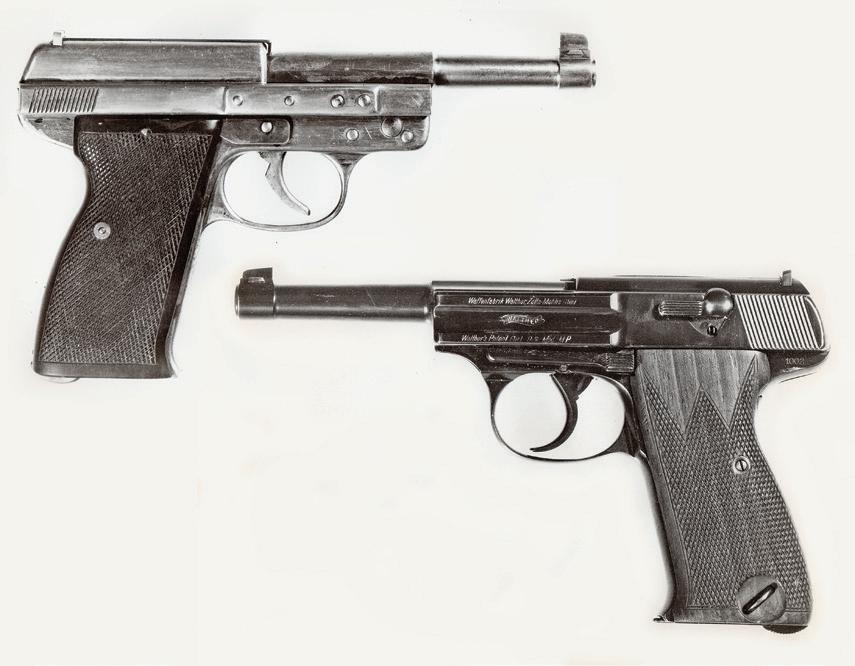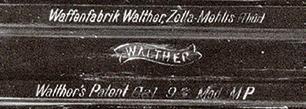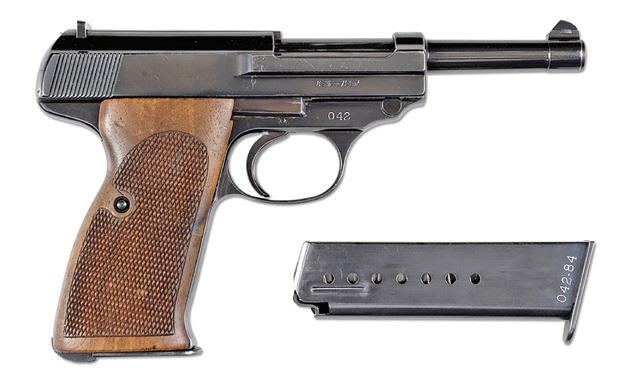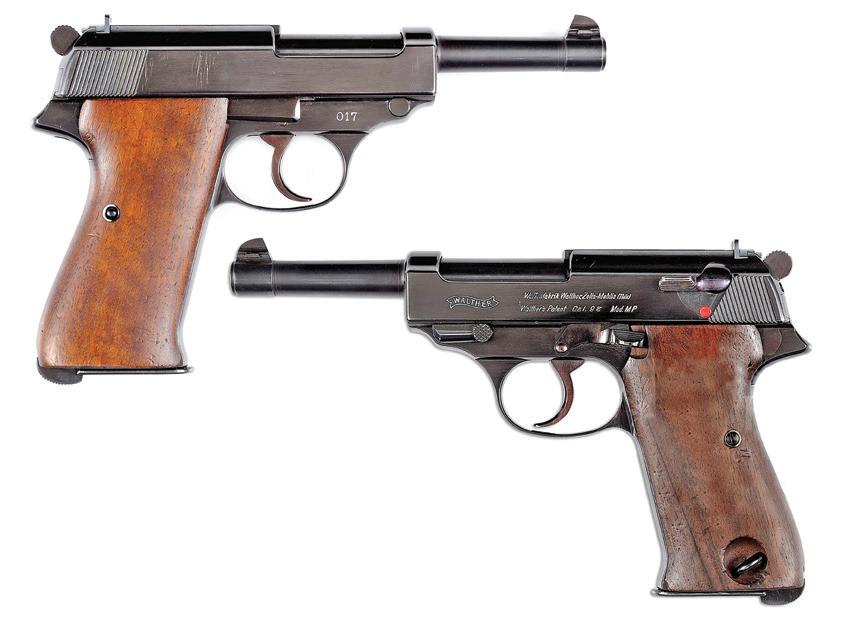DEVELOPMENT
Semi-automatic innovation
THE FIRST PISTOLS
In 1905, Fabrique Nationale d’Armes de Guerre, working in Herstal near Liége in Belgium, introduced a Browning-designed blowback pocket pistol. This proved to be a runaway success, selling 100,000 by 1910. Carl Walther was just one of many who tried to design an effectual rival, but his first pistol, now sometimes identified as the Venus-Pistole, was a failure. Clearly inspired by the 1900-type FN-Browning, its recoil spring lay in the slide above the barrel.
Success did not come until Carl Walther’s eldest son, Fritz, born in 1889, joined his father’s company after serving an apprenticeship elsewhere. The existence of the 6.35mm Selbstladepistole Modell 1 seems to have been announced in 1911, although some of Walther’s sales literature, apparently in a later attempt to discredit Mauser, subsequently offered dates as early as 1908.
Though fewer than 30,000 Modell 1 pistols had been sold when World War I began – sales of the FN-Browning had by then topped 1 million – Walther’s name had been established throughout Germany. The 1911 ALFA catalogue indicates that the Modell 1 pistol, retailing for 42 Marks, was cheaper than virtually all of its rivals excepting the Spanish-made Royal (40 Marks). The Pieper Modèle 1909 cost 45 Marks, while the FN-Browning cost 53.20 Marks; and the 6.35mm Bayard (made by Anciens Établissements Pieper) sold for 56.40 Marks. Emboldened, the Walther company introduced other pistols by 1914. The onset of World War I placed such great demands on output that a new building was erected in Zella St. Blasii and the old factory was sold to the gunmaker Oscar Will.
Walther’s impressive Zella-Mehlis factory, pictured in the early 1920s. (Author’s collection)
The Modell 2 pistol was a simplified Modell 1, introduced commercially in 1914 even though Walther’s sales literature sometimes misleadingly dated it to 1909. About 19,000 Modell 2s were made before production ceased in 1915, the highest serial number noted being 71556 although several thousand Modell 3 pistols were numbered in the same range.
The Modell 2’s recoil spring is concentric with the barrel, being compressed against the standing frame by the knurled collar at the muzzle, and the original safety button was substituted by a radial lever on the left rear of the frame. The dismantling system of the Modell 1 was replaced by a knurled collar which was simply unscrewed to allow the recoil spring to be released; the slide could then be retracted, raised and lifted clear. A magazine-safety system was also fitted to many of these Walthers, consisting of a small spring-loaded bolt mounted in the frame that disengaged when the magazine was removed. The muzzle-collar dismantling system was protected by German Patent 256606, granted on 22 October 1911, and the retractable combination back sight/cocking indicator found on early pistols by 271863, granted in January 1913. The sight remained in its slide housing when the chamber was empty, but rose into the firing position when a cartridge entered in the chamber.
The Modell 3 pistol – notably better finished than the Modell 1 –appeared c.1913–14, even though Walther’s sales literature sometimes claimed 1910. Heavier and longer than the Modell 2, the Modell 3 chambered the 7.65mm Auto (.32 Browning) cartridge and had a detachable six-round box magazine in the butt. The advent of World War I meant that only a few thousand of these pistols were made, however.
The 7.65mm Modell 4 pistol (see pages 8–9) was acquired by the military authorities, while the Modell 5 pistol was a variant of the Modell 2. Although Walther’s sales literature claimed that the Modell 5 dated from 1913, it actually appeared in 1915. Several machining
The 6.35mm Modell 1 pistol laid the basis for the Walther company’s subsequent success. (Hermann Historica, www.hermann-historica.de)
THE MODELL 4 AND MODELL 6
In May 1915, the GPK (Gewehr-Prüfungs-Kommission; Weapon Examination Commission) placed an order for 250,000 Modell 4 pistols as Behelfspistolen, substitutes for the standard service pistols, allowing the latter to be released for front-line duty. Consequently, many pre-1918 Walthers bear tiny military inspectors’ stamps. Carl Walther did not live to see this guarantee of his company’s success, however, dying on 9 July 1915 at the comparatively early age of 56.
Essentially an enlargement of the Modell 3 and sharing that pistol’s unusual leftward ejection, the earliest Modell 4 pistols had a small dismantling catch on the front lower right side of the slide. The grip had been extended to accommodate two extra cartridges, while a light sheet-steel shroud projected from the slide to cover the extended barrel. Attached by a bayonet fitting, the shroud compressed the mainspring – concentric with the barrel – against a barrel-mounting block integral with the frame.
The extractor was exposed on the left side of the slide behind the ejection port; the trigger bar was exposed on the left side of the frame; and 12 retraction grooves, milled vertically, were in the slide above the grips. A radial safety lever on the rear left side of the frame behind the grip locked the hammer in the cocked position when rotated rearward to cover the letter ‘F’.
The combination back sight/loaded-chamber indicator had soon been replaced by a robust ‘V’ notch which was simpler, stronger
and better suited to hard use. Changes to the stripping procedure required the muzzle shroud to be released by pressing inwards and unlocking by turning it through 90 degrees. The recoil spring then pushed the shroud forward out of the slide.
The updated Modell 4 had seven broad retraction grooves in the slide, milled diagonally, though the partially exposed trigger bar and leftward ejection were retained.
The GPK contract proved too much for Walther’s facilities, and the company was forced to subcontract manufacturing work to Immanuel Meffert (mark IM), who in turn passed on some of the work to Christoph Funk (F), Heinrich Gering (G), F.W. Kessler (F.W.K.), Heinrich Krieghoff (an anchor motif), Mercedes Buromaschinen (M), Gebrüder Merkel (a shield bearing a GM monogram), Gebrüder Rempt (GR), Schmidt & Habermann (S&H), August Schuler (AS) and Sempert & Krieghoff (no special mark, though S&K has been found on pistols sold commercially).
Subcontractors’ marks will be found on the side of the trigger-guard web with the exception of Krieghoff’s (on the left).
Large numbers of Modell 4 pistols were made in 1915–29, their serial numbers reportedly ranging from 20001 to 493750 but with gaps. The block 100001–275000 and possibly beyond seems to have been allocated to the military purchase. Markings customarily included ‘SELBSTLADE-PISTOLE CAL. 7·65.
WALTHER’S PATENT.’ over the banner trademark on the left side of the slide, and, on Walther-assembled examples, ‘Carl Walther
A typical wartime 7.65mm Modell 4, shown with its original holster, no. 65805 displays an anchor on the trigger guard showing that –Walther slide marks notwithstanding – this particular pistol was actually made by Heinrich Krieghoff during World War I. (Amoskeag Auctions, www.amoskeagauction.com)
WAFFENFABRIK Zella St. Blasii.’ on the right. In 1919, however, Zella St. Blasii and Mehlis were united and pistols still to be assembled were duly marked ‘Zella-Mehlis’. Grips generally bore ‘CW’ monograms.
In 1915, the military authorities requested pistol makers to submit simple designs that could chamber the standard 9mm Pistolenpatrone 08 cartridge. Walther offered the Modell 6, little more than an enlargement of the Modelle 5 and 7 sharing the blowback operation and an extension sleeve over the muzzle. The GPK also considered the 9mm Dreyse Pistole, which solved the cocking problem by including a separate cocking lever that worked at a mechanical advantage. Both pistols were rejected as unsuitable for military service, however, and design work soon ceased: the authorities had always viewed blowback pistols with suspicion, as anything more powerful than the 7.65mm (.32 ACP) Browning pistol cartridge increased chamber pressures, which promoted premature breech opening and casehead separations.
The Modell 6 relied on its powerful recoil spring and the sturdy slide/frame construction of the Modell 4 to prevent the slide being blown off and into the firer’s face in an emergency. The barrel screwed into the standing frame, and the recoil spring was concentric. A lightweight sheet-steel shroud, carrying the fixed front-sight blade, attached inside the slide mouth by means of a bayonet joint. The pistol was hammerfired and the trigger bar, positioned in the right side of the frame well, acted as a disconnector. A radial safety lever lay on the frame behind the left grip, and the magazine held eight rounds.
The slide had seven broad retraction grooves, milled diagonally, with ‘Selbstlade-Pistole Cal. 9m/m. Walther’s-Patent.’ on the left side above the banner trademark and ‘Carl Walther, Waffenfabrik, Zella St. Bl.’ on the right side. The chequered grips displayed ‘CW’ monograms. Serial numbers have been reported in the 591–1039 range, but whether they began at 1 is still unknown.
Modell 6 pistol no. 1030 was
A typical 7.65mm Walther Modell 7, dating to post-1919 owing to the inclusion of ‘Zella-Mehlis’ in the mark on the right side of the slide. (Hermann Historica, www.hermann-historica.de)
revisions were made to simplify (and hence cheapen) the manufacturing process. The 1913-patent back sight was discarded in favour of a fixed ‘U’ notch on all but a handful of the earliest examples that incorporated old slides; 16 narrow retraction grooves replace the original nine. Assessing how many Modell 5 pistols were made is complicated by Walther’s penchant for mixing the serial-number ranges, but may have amounted to 120,000, with many bearing the company’s post-1919 address: Zella St. Blasii and neighbouring Mehlis had amalgamated to form Zella-Mehlis, slide marks changing accordingly.
The Modell 6 pistol (see pages 8–9) was the unsuccessful 9mm Parabellum military adaptation of the Modell 4. The 7.65mm Modell 7 pistol, apparently introduced in 1916, had a slide like that of the Modell 5 and an elongated grip which accepted an eight-round magazine. The Modell 7 shared the dismantling system, safety mechanism and trigger of the Modell 5, but the hammer-type firing mechanism of the Modell 4 replaced the Modell 5’s striker. Ejection is to the right and, as the extractor is set into the surface of the slide at the bottom of the ejection port, spent cartridge cases have a higher trajectory on ejection than those ejected from the Modell 4. Serial numbers reportedly run from 4001 to 84000 in the sequence that also contained Modelle 4 and 5 production.
The 11 November 1918 Armistice stopped pistol production in the Zella St. Blasii factory, but the workforce of 75 in 1915 had subsequently grown to nearly 500 to meet wartime demand and many men found themselves without employment once production had ceased. In desperation, Walther turned to manufacturing optical components until the Allies allowed assembly of the Modelle 4, 5 and 7 pistols to resume in 1920–21. During the intervening period, the towns of Zella St. Blasii and Mehlis had united, forming Zella-Mehlis, and Walther had developed improved pistol designs. A German patent granted in May 1921 (DRP 365265) included details of an improved striker mechanism ‘for guns with closed frames’.

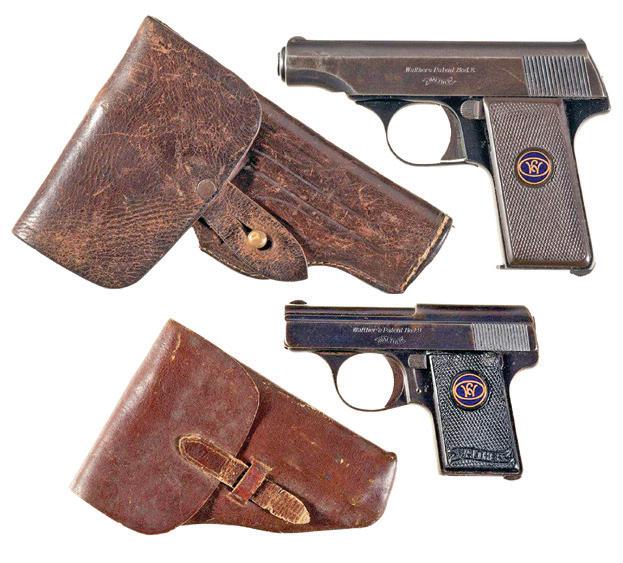
The 7.65mm Modell 8 and 6.35mm Modell 9 pistols appeared in 1922, and were so successful that manufacture of the Modelle 5 and 7 was discontinued. Manufacture of the Modell 4 continued until 1924, although ‘new’ pistols were still being assembled from existing parts as late as 1929. Walther’s management realized, however, that limited commercial demand would continue for as long as the Great Depression persisted, and that unless a more powerful design was perfected, no new orders would be forthcoming from the armed forces. The Modelle 8 and 9 were produced in large quantities, with serial numbers of the Modell 8 continuing where those of the Modell 5 had stopped, running from 390001 to about 96900A, while those of the Modell 9 ran from 410001 up to 198000N. The suffixes had been added when each series had reached 1 million. Total production, therefore, has been estimated at about 146,000 Modell 8 and 249,000 Modell 9 pistols.
During this period, at least one toggle-lock pistol was assembled in accordance with patents granted to August Menz (see, particularly, DRP 326798 of 19 July 1916). Production of calculators also commenced – diversification had become the name of the game – but under the able guidance of Georg Walther, sales of pistols exceeded expectations. Fritz ran the firearms business; Erich concentrated on sales and distribution. Together, the brothers built a large and efficient organization.
Fritz Walther had begun to redesign the blowback pistols on which the company’s success had been built. From this era came the first of the Sportpistolen; widely (but mistakenly) believed to have been introduced just before the Los Angeles Olympic Games of 1932, they actually date
The large 7.65mm Modell 8 and small 6.35mm Modell 9 pistols with their holsters. The Modell 9 was the first of a new class of pistol – Westentaschenpistolen (‘shirt pocket pistols’) – and inspired countless copies including the Mauser WTP 1, which appeared in 1923: The Walther and Mauser companies shared an intense rivalry, ensuring that whatever move one made, the other promptly countered. (Rock Island Auctions, www.rockislandauctions.com)
This Polizei-Pistole, no. 2, is believed to be a prototype or developmental model. The front of the slide is retained by a dovetail engaging a T-section frame extension, some of the lockwork components differ from the perfected parts, and the base of the magazine has an unusual alloy extension. (Morphy Auctions, www.morphyauctions.com)
from 1926–27. Then, in 1929–30, design of the Polizei-Pistole finally was perfected; patent DRP 578765 of 7 November 1930 protected its sophisticated safety and de-cocking systems.
THE POLIZEI-PISTOLE
The introduction of the Polizei-Pistole , generally known by the abbreviation ‘PP’, revolutionized the part of the firearms industry that was making pocket and personal-defence pistols. Up to that time, the Browning blowbacks made by Fabrique Nationale d’Armes de Guerre and Colt (not to mention the legion of Spanish copies) had held a virtual monopoly.
There has been much purposeless discussion concerning influences on the creation of the Polizei-Pistole. Fritz Walther’s detractors point to the work of two lesser-known inventors, Alois Tomiška and Sergei Korovin, both of whom had patented double-action trigger systems prior to 1914. Production of Tomiška’s Little Tom pistol, though comparatively small, created enough of a reputation to attract Fritz Walther’s attention. In 1922, Fritz is said to have approached Tomiška seeking to market pistols incorporating the latter’s patents. After purchasing the rights, however, Fritz either deliberately stalled until the basic patents expired, or laboured unsuccessfully to adapt the Little Tom to the company’s massproduction methods.
During this time, however, Fritz amalgamated Tomiška’s ideas with some of his own, and approached the Deutsches Patentamt with his
THE PP REVEALED
9mm Polizei Pistole
The Polizei-Pistole action is relatively simple. Pressure on the trigger ( 28 ) draws the trigger bar ( 18 ) forward, rotating the hammer by the action of the sear/hammer lifter ( 16 ) on the hammer-lifting arm. At the same time, the sear also lifts the hammer lock by pressing upward on it; only when the hammer lock is fully elevated can the hammer strike the firing pin. At all other times, the passage of hammer to pin is prevented by the interposition of the hammer lock on the hammer-body projection. When the hammer-lifting arm has rotated the hammer to its rearward limit, the sear disengages and the hammer flies forward to a position where (now that the hammer lock has been lifted) it can strike the head of the firing pin.
The pistol then fires, whereupon the slide reciprocates, riding over the hammer and forcing it back until the sear engages. The trigger bar has been disconnected from the sear during the recoil stroke, so the firer must release the trigger before the trigger bar can be pulled back to re-engage the sear. The trigger bar and the sear are enveloped by the metal of the sear itself, resulting in a captive system all but incapable of malfunctioning.
The trigger mechanism can be operated by thumb-cocking the hammer, when, owing to the deletion of the motion for which most energy was required – rotating the hammer to full cock by pressing the trigger – better accuracy results from the appreciably lighter pressure needed to release the hammer from the sear.
Front sight
Slide
Barrel
Recoil or return spring
Rifling
Cartridge in chamber 7. Firing pin
8. Firing-pin spring
13. Hammer
14. Firing-pin lock spring
15. Firing-pin lock
16. Sear/hammer lifter
17. Sear spring
18. Trigger-bar tip
19. Hammer-spring strut
20. Grip screw
21. Grip
9. Signal pin/loaded-chamber indicator 10. Signal-pin spring 11. Back sight 12. Safety-catch spindle
22. Magazine
23. Magazine spring
24. Cartridges in magazine
25. Trigger-guard plunger
26. Trigger-guard plunger spring
27. Magazine catch
28. Trigger 29. Trigger spring
30. Trigger guard
31. Frame
WALTHE
The 7.65mm PPK no. 259811K, probably dating from 1940, still has ‘crown/N’ proof marks (not visible in this view). The 60-degree safety catch was introduced in 1938; the plush and satin-lined case was an optional extra. (Hermann Historica, www.hermann-historica.de)
perfected designs. The resulting Polizei-Pistole was infinitely better than the Little Tom: strong, durable in spite of its complexity, elegantly designed and cleverly packaged, it had no peer in 1930. Consequently, the Polizei-Pistole (PP) and its reduced-size derivative the PPK were destined to be produced in huge quantities. When the Allies seized Zella-Mehlis in the spring of 1945, output of PPs was estimated to have been approximately 540,000, apparently numbered from 700501 to 397000P, alongside a little over 290,000 PPKs (754950–431097K).
The Walther pistol was known to the factory as the ‘Selbstlade Pistole Modell 1930’, after the year of its first commercial appearance, but was based on a series of patents granted to Fritz Walther in 1928–29. Initial advertising listed its dimensions as 170mm overall length, with a 98mm barrel, and a weight of about 600g. The pistol was 22mm thick and approximately 109mm high, and carried a detachable eight-round box magazine in the butt. It chambered the popular 7.65mm Auto (.32 Browning) and 9mm Short (.380 Browning) cartridges.
The earliest catalogue illustrations show ‘The New Walther Police Model’ with a slide marked ‘Waffenfabrik Walther. Zella Mehlis
(Thür.)’ over ‘Walther’s Patent. Cal. 7,65 m/ m’ ahead of the banner trademark, which lies in front of the safety lever thumbpiece. No Polizei-Pistole has yet been found matching this artist’s impression, however. The Walther banner is shown moulded into the base of the injection-moulded plastic grips, a signal pin is present above the hammer, and a magazine extension is stated as being available. It is notable that there is no ‘Mod. PP’ mark on the pistol; Walther apparently intended to call it the ‘Modell 10’, continuing the previous numerical sequence, before having a last-minute change of mind. The final prototype seems to have borne the serial number 750000, series production beginning at 750001.
The Polizei-Pistole was the first commercially successful pistol embodying a double-action trigger system that could fire by thumbcocking the hammer or by simply pulling through on the trigger. Most previous pistols had used a single-action system in which the hammer had to be thumb-cocked or the slide retracted to cock and load. Walther is certainly not due credit as the father of double-action trigger systems, however. Such triggers had been successfully applied to pepperboxes and revolvers in the 19th century – designs from Cooper, Remington and others had seen service in the American Civil War (1861–65) – and many major manufacturers had successfully marketed them prior to 1914.
The PPK
The Polizei-Pistole was intended as a small holster pistol, but the state police of Prussia apparently indicated that a smaller pistol would be necessary for concealment in a shoulder holster. The result was what is now generally known as the ‘Polizei-Pistole, Kriminal’ or ‘PPK’; the origin of the designation, however, is still questionable. Explanations offered for the ‘K’ suffix include Kriminal[-polizei], kurz (‘short’) and klein (‘small’). The abbreviation should perhaps have been written ‘KPP’, but PPK persisted and Walther ultimately added it to slidemarking dies. The Walther broadsheet inserted in the 1943 edition of Karl Fischer’s Waffen und Schiesstechnischer Leitfaden für die Ordnungspolizei (Regular Police Force Technical Manual on Weapons and Shooting) fails to mention Kriminalpolizei in connection with the pistol. There is a suspicion that the pistol may originally have been called Kleine Polizei Pistolen (‘small police pistol’) until the advertising merits of Kriminalpolizei became obvious.
The first PPKs seem to have reached the commercial market in 1931. Pistol no. 754958 is a PPK marked as a Polizei-Pistole, but has a frame lacking the rear strap; consequently, the first correctly marked PPK may have been no. 755001. The prototype PPK is believed to have a reduced but conventionally forged grip, with front and back straps, and separate grips. However, the perfected version had an abbreviated grip with only a front strap, plus an enveloping one-piece grip.
Polizei-Pistole variations
The earliest Polizei-Pistolen, numbered below about 765000, had a split or two-piece firing pin and a bent riband spring for the firing-pin lock; the firing pin could not be seen when the safety catch was in the ‘safe’ position. The early ‘fat’ safety lever, which came with the two-part firing pin, had seven flutes; the later ‘slim’ version had just five flutes.
The firing-pin assembly was composed of the safety-catch lever, the small firing-pin piece, its spring and a retaining piece, the firing-pin block (pinned in the slide), the long firing-pin piece and its spring, but was deemed unnecessarily complicated. Consequently, some of the parts were simplified at about the time the PPK appeared. The first stage was to simplify the firing-pin assembly, which thereafter consisted of the 90-degree safety-catch stem and firing-pin block (in the slide), together with a one-piece firing pin powered by a small coil spring. The replacement of the riband-pattern firing-pin lock spring with a small coil occurred next, together with revisions to the frame and sear.
A further modification to the safety catch was made in the mid-1930s, when the support block for the firing pin, previously pinned in the slide, became integral with the slide itself. The barrel was rebated for part of its length to increase the clearance for the recoil spring, the signal pin was revised (its spring moving from behind the shoulder to in front) and the hammer was grooved to clear it.
Some Polizei-Pistolen, especially those acquired for the Reichsbank (Central Bank), were duly modified to accept the new firing-pin/spring assembly, probably when they were returned to the Reichsbank’s own armourers for repairs, or to the factory after supplies of the original components had been exhausted. These modified pistols can sometimes be identified by serial numbers engraved vertically on the right side of the slide ahead of the retraction grooves.
The earliest Polizei-Pistolen often lacked the signal pin that protruded from the rear of the slide above the hammer when there was a cartridge in the chamber. Originally optional, this feature proved so popular that it was virtually standardized after 1933. As late as 1935, however, pistols were being offered with the signal pin at an additional cost.
The earliest PP hammers were not grooved to accommodate the signal pin, which was driven forward to nick the rim of the chambered cartridge each time the hammer fell. This oversight was soon corrected, and is rarely if ever encountered on the PPK.
In about 1937, the 90-degree safety catch was replaced by a shortthrow 60-degree pattern and a change was made in the slide to accommodate it. The original hammer, with a small transverse hole, was replaced by a lightened pattern with a markedly larger hole.
Apart from changes in markings, no important alterations were made until – in 1943 – the step behind the rear trigger-guard pivot, below the magazine catch, was eliminated to save machine time. The projection of the frame beneath the hammer had been lengthened slightly earlier to answer complaints that the web of the firer’s thumb could be caught by the hammer. This change occurred in the region of pistol no. 220000P but some degree of overlap is to be expected.
The quality of the finish deteriorated as the war progressed, from a rich commercial blue to a blue-wash over the major components. Fine polishing and attention to detail were sacrificed in pursuit of speed of manufacture, post-1942 pistols often showing coarse milling marks, and squared-off edges became sloppily rounded. Pistols made towards the end of the war abandoned the signal pin to simplify production, and, finally, shortages of oil required to mould the plastic grips forced the substitution of pressed wood-fibre grips.
Accessories included a Leuchtkorn luminous radium night sight, which clipped around standard front sights in which a distinctive notch had been cut; extension magazines, some containing two additional rounds and others with luminous, red or green bases, were also available.
Many 7.65mm pistols will be found with lanyard loops set in a screwed-in eye on the base of the butt on the left side: these were generally added after World War II to virtually any pistol which was considered to be in good enough condition for issue to the French armed forces. Original Walther-made loops, fixed on the base of the butt behind the magazine well, were commonly found on pistols issued to the Swedish police.
A few 7.65 and 9mm pistols had been provided with butt-heel magazine catches in 1937–38, and some 9mm examples were purchased by the HWaA (Heereswaffenamt; Army Weapons Agency) during World War II. Whether the military authorities were simply buying pistols that incorporated parts left in stock, or whether they were worried about the efficacy of the standard cross-bolt magazine catch cannot now be determined; the P 08 had used a cross-bolt catch for 30 years, but the butt-heel pattern was easier to make and less likely to be depressed by a nervous firer. Butt-heel magazine-catch pistols are generally confined to 9mm Polizei-Pistolen and those used by Polizei-Direktion München (Munich Police Department) marked ‘PDM’.
Alloy frames fitted to experimental Armee-Pistolen and HeeresPistolen in the late 1930s proved incapable of withstanding the battering of 9mm Parabellum ammunition, but the duraluminium frame first tried on the Polizei-Pistole in 1933 proved to be much more successful: the low power of the 7.65mm and 9mm Short cartridges avoided ‘fretting’, resulting from friction between steel and alloy surfaces as they meshed. Alloy-frame pistols were produced in quantity from c.1933 in the regular serial-number ranges from about 802000 onward. Pre-war examples were anodized an attractive shade of blue, but most wartime-made pistols had a baked-on black paint finish.
The PPK had an abbreviated grip with only a front strap, enveloping one-piece grips and a shortened frame. As the sear rotated through an aperture cut in the frame, however, a weakness lay in the area of the backstrap joint, even in the Polizei-Pistole. Alloy frames were particularly prone to cracking until changes in the machining process created a bridge of metal to act as a strengthener. This necessitated a change in the sear design, and the trigger-bar actuating spring was discarded once it was found that the trigger spring could be bent far enough to fulfil the same function.
Additional chamberings
The successful introduction of the PP and PPK in 7.65mm and 9mm encouraged Walther to add 6.35mm and 5.6mm (.22LR) chamberings, but using four different cartridges required differing rifling to maintain optimal performance. All PPs and PPKs were rifled with six grooves, but the clockwise twist made one complete turn in 190mm (6.35mm), 210mm (.22 and 9mm) or 240mm (7.65mm).
The 7.65mm pistols were by far the most popular of the chamberings, production being estimated at 502,000 PPs and 270,000 PPKs. The 9mm version was much less popular, however, though the Luftwaffe seems to have acquired a substantial number. Output is estimated at a mere 19,000 PPs and 10,000 PPKs, numbered in the 782300–321410P and 705900–303590K groups respectively.
The 5.6mm chambering had some value for training, but the 6.35mm version was deemed too ineffectual to be satisfactory for personal defence. Indeed, on 8 November 1943, the OKH (Oberkommando des Heeres; High Command of the Army) ordered all pistols with calibres of 6.35mm or under to be withdrawn from service. One estimate suggests that production of the 6.35mm pistols amounted to just 400 PPs and 220 PPKs, their serial numbers being scattered within the 76260–910950 and 774600–930650 groups.
The 5.6mm lfb (.22 Long Rifle rimfire) Polizei-Pistole, introduced in 1932, soon proved to be a better commercial proposition than the ill-fated 6.35mm version. Changes were made to the standard centrefire ignition system, and the signal pin was omitted as it would have rested on the primer-containing cartridge rim.
A few rimfire pistols were acquired by the HWaA and the RZM (Reichszeugmeisterei; State Material Control Office) for training. Their slides were marked conventionally, except for ‘Cal. .22’; this was handstamped until the rimfire variant became successful enough for the calibre to become part of the slide-inscription die. The pistols cost RM 49.5 in the mid-1930s, special extra-long walnut grips being RM 10.5 extra. No decision to discontinue production was ever taken, but wartime concentration on the 7.65mm and 9mm patterns meant that few rimfires were made after 1940 – though, ironically, many of the late-production pistols made in 1945 (in the 430000 group) chambered the 5.6mm round. Introduced in 1932, fewer than 500 Polizei-Pistolen in 6.35mm Auto (.25 Browning) calibre were made before production ceased in 1935. They were simply too big for the minimally powered cartridge, and much too expensive. Numbered between 775000 and 780000, the 6.35mm Polizei-Pistolen displayed the banner trademark on the slide ahead of ‘Waffenfabrik Walther. Zella Mehlis (Thür.)’ over ‘Walther’s Patent Cal. 6.35m/m’; in addition, ‘Mod. PP’ (or ‘Mod. PPK’) lay immediately ahead of the safety-catch thumbpiece. Examination reveals the calibre marking to have been hand-stamped, the remainder of the mark being rolled in.
Known officially as ‘Selbstlade Pistolen Walther, Polizei Modell, Kaliber 7.65mm’ or simply as ‘P W PP Kal.7,65’, the 7.65mm Auto (.32 Browning) – chambering a low-power cartridge ideally suited to blowback operation – was the most popular of the four regular Polizei-
Pistolen. Introduced late in 1929, numbered from 750001 and followed by PPKs from no. 778500, the slides are marked identically with the 9mm version, except for ‘Cal. 7,65m/m’.
Production continued during World War II, serial numbers becoming separated into separate blocks once they reached 1 million. PolizeiPistolen were given a ‘P’ suffix, while the PPK was distinguished by ‘K’. A few pistols were made in 1945 with the original Walther code-mark replacing the banner trademark; they are marked, typically, 384771P above a large ‘ac’ on the right side of the slide (not the left) and were apparently confined to the 370000P–394000P block. Lastly, perhaps 2,000 Polizei-Pistolen produced in the final weeks of the war bore no marks other than an occasional proof. The highest recorded PP serial number is currently 399990P; PPK numbers reach at least 431332K, but no PPK has been seen with ‘ac’ marks.
Introduced in 1933, and chambering the popular but ineffectual 9mm Short cartridge, serial numbers of the 9mm Kurz (.380 Browning) subvariant began at about 782300 and continued, interspersed with PPKs and other PPs, to 999999. The numbering sequence recommenced at 100001P in 1939. Slides displayed the banner trademark ahead of ‘Waffenfabrik Walther. Zella Mehlis (Thür.)’ over ‘Walther’s Patent Cal. 9m/ m’. The designation mark, ‘Mod. PP’, lay behind the maker’s mark ahead of the safety catch thumbpiece. The pistols were officially known as the ‘Selbstlade Pistole Walther, Polizei Modell, Kaliber 9mm kurz’, but this was widely abbreviated to ‘P W PP Kal.9’. Early Polizei-Pistolen in this chambering still had the frame-mounted magazine-release button, whereas later ones had the butt-heel type.
Awarded in 1939 to the winner of the SS (Schutzstaffel; Protection Squadron) national pistolshooting competition, .22-calibre PPK no. 214094K displays an ‘after-market’ eagle-and-swastika Hoheitsabzeichen (national emblem) on the grip. (Rock Island Auctions, www.rockislandauctions.com)
Ulm-made 7.65mm PPK no. 255558, proved in 1971, is shown with a detachable silencer. Silenced Walthers were used by the infamous Stasi, the police unit of East Germany’s Ministerium für Staatsicherheit (Ministry for State Security), and seven are known to have been assembled in the late 1950s by London gunmakers Cogswell & Harrison in response to an order placed by Saudi Arabia. (Arundel Militaria, www. deactivated-guns.co.uk)
Non-standard Polizei-Pistolen
Developmental prototypes often differed considerably from one another in detail. Some have been reported with single-action triggers and at least one with an additional Modell 9-type safety protruding from the top of the left grip.
Ten long-barrelled Polizei-Pistolen (six blued, four matt-chromed) were supplied to Waffen Glaser of Zürich, Switzerland, in the mid-1930s. Chambering the 7.65mm cartridge, these pistols had barrels and slides approximately 25mm longer than usual and non-standard recoil springs. Their numbers remain uncertain, but included 779150 and 779153.
At least one fully automatic pistol was made from an altered PolizeiPistole slide/frame unit, with the grip widened to accept a 15-round staggered-row box magazine. This 9mm pistol has post-1940 ‘eagle/N’ nitro proofs, a standard Polizei-Pistole trigger system and an additional selector lever on the right rear of the frame marked ‘D’ (rear) and ‘E’ (front), presumably the abbreviations for Dauerfeuer (automatic fire) and Einzelfeuer (semi-automatic fire). The selector works by isolating the disconnector.
Silencer-fitted pistols are also reported from time to time. Some are after-market adaptations, but others were made during World War II for the RSHA (Reichssicherheitshauptamt; State Security Main Office), created on 27 September 1939, which supervised acquisition of weapons by the Sicherheitspolizei (Security Police), Kriminalpolizei (plainclothes police), Geheime Staatspolizei (Gestapo; Secret State Police) and Sicherheitsdienst (SD; Security Service).
The KPK
Thought to have been designed in about 1942, this little-known derivative of the Polizei-Pistole has grips like those of the Ehrenwaffe des Politischen Leiters (honorary firearm of the political leadership), displaying a moulded eagle-and-swastika motif, and trigger and sear systems duplicating the PP and PPK. The earliest prototypes of what has been listed as the KriminalpolizeiPistole-Kurz seem to have had PPK slides, but later examples used a special slide lacking the safety catch. The rear of the slide was extended to shroud all but the tip of the hammer. Surviving KPKs have blued steel slides bearing a banner and ‘KPK’, while the alloy frames are generally unfinished. Chambering seems to have been confined to 7.65mm Browning; overall length was about 158mm and weight with an empty magazine was a mere 415g.
ULTRA-PISTOLEN
Early in the 1930s, the management of Gustav Genschow & Co. AG (Geco) of Karlsruhe-Durlach decided to rationalize the range of cartridges used in blowback pistols. The 6.45mm Geco, developed in 1933, was intended to replace the 6.35mm and 7.65mm Browning rounds.
Trials were apparently undertaken with specially chambered Polizei-Pistolen, but the 6.45mm cartridge proved to be unsuccessful, possibly because advantages over its industrystandard rivals were too meagre to justify manufacture. Genschow, by no means discouraged, then produced 8mm and 9mm Geco patterns in 1934. Only the 8mm version, appreciably more powerful than 9mm Short, was produced in quantity and –once again – it is assumed that Walthers were used during development.
Early in 1936, the OKL (Oberkommando der Luftwaffe; High Command of the Air Force) learned of Genschow’s plans. The Luftwaffe saw the 9mm Geco Erhöhte-Leistungs-Patrone (enhanced-performance cartridge), less powerful than 9mm Parabellum, as being ideally suited for compact blowback pistols
destined for aircrew. Renamed ‘9mm Ultra’, the cartridge fired a 7g bullet at 300m/sec – potentially a good man-stopper – but only 20,000 cartridges are said to have been produced before the proximity of war, large-scale rearmament and a genuine lack of need brought production to an end.
Ten Polizei-Pistolen chambering the 9mm Ultra cartridge are also said to have been assembled, though evidence is lacking. At least one Ultra-Pistole was made on the basis of the PP, however. The Ultra-Pistole has an abbreviated slide from which the barrel protrudes, but the greatest difference concerns the position of the recoil spring. The exposed barrel, rendering a concentric spring impracticable, forced the designers to adopt an indirectspring system somewhat similar to that of the Mauser HSv. The position of the trigger components precluded the use of levers on both sides of the frame, however, and it is likely that asymmetrical stresses created by firing compromised long-term utility. In addition, the onset of war may have had an influence: in September 1941, the OKL ordered 2,000 Polizei-Pistolen and effectively consigned the Ultra-Pistole project to history.

The Ultra-Pistole relied on a square-section actuating spring pinned to the lower front left side of the butt acting on a lever to hold the breech shut. The recoiling slide then rotated the lever back against the spring, which compressed against shoulders on an auxiliary strut. (Morphy Auctions, www.morphyauctions.com)
The Militär-Pistole is considerably bigger than the Polizei-Pistole, usually with a parallel side grip and a lanyard loop on the butt heel. Its slide displays the banner trademark ahead of ‘Waffenfabrik Walther. Zella Mehlis (Thür.)’ above ‘Walther’s Patent Cal. 9m/m’. The designation ‘Mod. M. P.’ lies behind the main inscription immediately ahead of the safetylever thumbpiece. Production was meagre; surviving pistols are numbered 5008 and 5009, and a ‘still to be authenticated’ 5016, which suggests that the prototype – ‘MP 0’, in accordance with nomenclature suggested by Karl Schäfer in the Deutsches WaffenJournal – was numbered 5000 or 5001. MP I no. 5009, shown here, has a straight grip, but others survive with an arched back strap. (Rock Island Auctions, www.rockislandauctions.com)
TOWARDS THE P 38
Suggestions that the P 08 (‘Luger’) pistol should be replaced by something simpler had been made to the Waffenamt der Reichswehrministerium (Weapons Agency of the Reich Ministry of Defence) as early as December 1926. In March 1927, a report noted that the simplest FN-Browning pistol required only 55 manufacturing procedures compared to about 1,180 for the P 08. Pistols submitted by Simson & Co. were tested in 1928–30 and a blowback pistol from machine-tool maker Richard Stock appeared in March 1931: the end was clearly in sight for the Luger, and among the contenders to replace it was the Walther Militär-Pistole
The Militär-Pistole
Apparently dating from 1930, the Militär-Pistole is a greatly enlarged Polizei-Pistole chambering the powerful 9mm Pistolenpatrone 08 cartridge. It seems to have been offered to the HWaA as a possible replacement for the P 08 at a time when the future of the latter was under review. However, although the Militär-Pistole was easy to make, being based on an existing pistol, it was rejected on account of its simple blowback operation: the HWaA wanted the safety inherent in a locked breech.
The MP II, believed to date from c.1931 and offered in 9mm Steyr in addition to 9mm Parabellum, relied on a separate block to delay the opening of the breech but was soon supplanted by the locked-breech MP III. Pistol no. 101, one of only two survivors of this ‘hesitation-lock’ MP II pattern, also has a spur hammer instead of a ring and is assumed to have been an attempt to satisfy HWaA demands before the blowback system was finally rejected. Possibly no more than 25 blowback MilitärPistolen were ever made, but their failure spurred Walther to develop the Armee-Pistole, the Heeres-Pistole and, finally, the P 38.
Trials and tribulations
When German rearmament began in earnest in 1934, German military experts had long since concluded that the P 08 was too difficult to make and too complicated to maintain under service conditions. Although the vast numbers of reworked and newly made Lugers satisfied the armed forces’ short-term needs, it was clear that a new long-term solution had to be found.
Large-scale trials intended to replace the Luger began in this period, but much of the story remains vague. Among the pistols known to have been submitted, however, were the Walther Militär-Pistolen, the Mauser HS and HSv, the Sauer Heeres-Pistole and a prototype from Berlin-SuhlerWerke. The Walther MP I, the HS and (probably) the Sauer were blowback pistols, the Walther MP II was a delayed-blowback pistol, and the HSv and the Berlin-Suhler-Werke prototype had breech-locks. Other weapons were probably tested by the HWaA, including the Belgian FN-Browning GP Mle 35 and the French Petter, but the Germans were keen to develop an indigenous design.
Two 9mm Parabellum blowback pistols, the Dreyse-Pistole and the Walther Modell 6, had been tested during World War I, but high residualpressure levels in such pistols inevitably led to extraction failures, broken extractors and case-head separations. Consequently, blowback pistols stood little or no chance of adoption, though many such weapons served aircrew, staff officers and paramilitary personnel with distinction during World War II. They all chambered low-powered cartridges such as the 7.65mm and 9mm Short.
The HWaA, deeming the margins of safety to be insufficient, predictably rejected blowback pistols in favour of the locked-breech submissions. Walther seems to have submitted the prototype ArmeePistole, the MP III, as trials were being undertaken with the Mauser HS and/or the HSv, which dates it to 1936. Faults were clearly found in the MP III’s design, however, and the HSv was judged superior in some respects.
Cleve Howell, reviewing the Mauser HSv in the August 1946 issue of The American Rifleman, observed that the Mauser slide, narrower than that of the Walther, reduced weight. This, he said, was important in the context of a military pistol. He also believed the Mauser HSv to have had better safety features and to be more pleasing aesthetically, but also noted that it was much more difficult to make in quantity than the Walther design. It is also believed that the locking system of the HSv, involving a rocking block located under the barrel, pinned at the rear, may have performed badly under service conditions. Whatever the reasons, the HWaA ultimately preferred the Walther MP III.
Walther had made a Menz toggle-lock pistol in the early 1920s, from which the twin lateral mainsprings of the MP III were adapted, and found inspiration for the locking-block system in the Mauser C 96 and the Bergmann-Mars. Work to develop a breech-locking system combining strength with simplicity is believed to have begun in 1935. By the end of the year, Fritz Walther and Fritz Barthelmes had developed a mechanism that was efficient enough to warrant applying for patents, evidence that dates development within a few months.
Walther (1889–1966) and his chief engineer Fritz Barthelmes (1899–1973), co-designers of the P 38. (Author’s archives)
Fritz
The sheet-metal Walther MP III (left) was the prototype of what became the P 38. The MP III bore the slide inscription ‘Waffenfabrik Walther. Zella-Mehlis (Thür.)’ above the company banner, which in turn appeared above the widely spaced ‘Walther’s Patent. Mod. MP’. The MP III was followed by the more conventionally constructed MP IV (right) with its distinctively shaped slide. The MP IV serial number, 1002, suggests the MP III may have been regarded as no. 1001 even if unmarked. (Author’s archives)
Refining the Militär-Pistole
The first locked-breech prototype pistol was probably made in Walther’s Zella-Mehlis factory late in 1935, but it would have been little more than a crude tool-room model intended to test the Walther–Barthelmes locking system. Once the efficacy of the basic design had been demonstrated, the MP III was assembled by more traditional methods to ensure a longer life. The new pistol may date either from the end of 1935 or the beginning of 1936, before the patent applications were filed (the first reaching the German agent office on 13 February): the illustrations accompanying the applications, notably for what was to become DRP 706038, are much more like the later Armee-Pistole. Additionally, the prototype MP III has a different locking mechanism in which the locking-block faces, actuated by cams cut in the sides of the slide, lie on the side of the breech.
The MP III differed considerably from the patent-specification drawings and the later Armee-Pistolen. A unique slide forging had two shallow protruding housings on each side, extending forward from a point level with the rear of the trigger guard. The slide-retaining or ‘holdopen’ catch was also unique, but the basic design features were clearly evident. The HWaA was quickly made aware that Walther’s locked-breech pistols existed, though few trials seem to have been undertaken until the perfected prototype (the MP IV or possibly the Armee-Pistole ) appeared c.1936.
The Armee-Pistole
Whether the Armee-Pistole and MP IV are contemporaneous is debatable, as it seems likely that the former was a direct descendant of the original MP I made before the German military authorities demanded an exposed hammer. The slide of the Armee-Pistole only had a single protruding housing on each side, the original locking block of the MP III having been replaced by an under-barrel pattern; the front of the slide had a barrel band to improve the slide/barrel bearing; and the frame-forging was wholly revised.
The slide-retaining catch was altered, although the efficient Luger-type radial dismantling lever was retained on the front left side of the frame. The Armee-Pistole utilized the double-action lockwork of its predecessors, the patented safety catch of the PP/PPK series (with 60-degree radial movement) and an enclosed hammer. The magazine catch remained on the butt heel and the slide had 16 diagonally milled retraction grooves.
Once development had proceeded sufficiently, work on a preproduction series began so that pistols could be supplied to the HWaA. While tests were being conducted, and because the authorities were keen to make them as rigorous as possible, Walther embarked on a series of experiments to discover if the Armee-Pistole had commercial appeal by distributing small numbers of pistols to the gun trade both inside and outside Germany. Serial numbers appear to lie between 01 and 051, but the unconfirmed existence of 0129 has been reported and output as high as 200 pistols has been claimed.
Armee-Pistolen, being largely hand-finished, differed in small details. Several different types of front sight and grips are known, though not all are original. Barrel lengths also vary: no. 010, for example, has a 20cm barrel, and no. 029 has a barrel so short that the front sight abuts the front of the slide. Most of the pistols chambered the 9mm Parabellum cartridge and bore the slide inscription ‘Waffenfabrik Walther, ZellaMehlis (Thür.)’ above ‘Armee-Pistole Cal. 9 m/ m’, a banner trademark being set into the front of the lower line. These marks appeared on the left side of the slide, with the upper line rolled into the protruding lock housing.
At least one pilot model was made for the 7.65mm Parabellum cartridge, which shared case-head dimensions with the 9mm Parabellum round and made conversion an easy task, while .38 Super and .45 ACP chamberings were developed to encourage US interest. It has also been rumoured that Armee-Pistolen were made or adapted for the short-lived 9mm Ultra cartridge, developed by Genschow in the late 1930s to explore the limits of blowback operation in handguns, but these Walthers were specially chambered Polizei-Pistolen and the so-called Ultra-Pistole Armee-Pistolen were sometimes accompanied by special holsterstocks, while development of aluminium frames was conducted in an effort to save weight and discover whether such alloys had any advantageous metallurgical properties. It is evident that fretting occurred after fewer than 2,000 rounds had been fired. The experiments were then abandoned, development of suitable aluminium-alloy frames awaiting advances in aerospace technology in the 1950s.
Armee-Pistole no. 042 was a refinement of the MP II, with a single external rib on each side of the slide instead of two. (Morphy Auctions, www.morphyauctions.com)
Armee-Pistolen resemble the later P 38, but their spurless hammer is carried within the closed rear of the slide. The shallow protruding housings, one forged into each side of the slide immediately below the breech, are also very distinctive.
The pistols were largely hand-finished from first-class materials and were generally beautifully rust blued. One plated specimen has been reported, but the finish may not be original. The grips were usually of high-quality partly chequered walnut, but they vary in style; some catalogue illustrations show the company banner stamped in the grips above the chequering, though this may simply have been artistic licence as no specimen has yet been found.
The manual safety was operated by a radial lever on the left rear side of the slide. Shoulders on its stem engaged recesses in the side of the firing pin, locking the pin in position, while the safety-catch stem acted as a decocking lever to lower the hammer. It could not strike the firing pin, because the locking block barred its passage. This feature was viewed with unjustifiable suspicion by detractors of the Walther design, but Hoffschmidt (1975: 11) observed that although it was disconcerting to see the hammer fall on a live cartridge, the system worked very well. The slide could be cycled with the safety catch in the ‘safe’ position, though the trigger stayed back and would not move forward until the safety catch was moved to the ‘fire’ position.
The design of the trigger mechanism and the safety catch was virtually beyond reproach apart, perhaps, from excessive complication. The multiplicity of manual and mechanical safeties made it impossible to fire the gun accidentally, however, while the multi-purpose trigger – the first of its type to be robust enough for military use – gave a choice of action. The pistol could be loaded and cocked by retracting the slide, and fired by an immediate pull on the trigger; or the safety catch could be used to drop the hammer safely onto a loaded chamber.
In the event of a misfire, the trigger could be pulled repeatedly, on each occasion delivering a fresh blow to the primer, but most suspect cartridges fired at the second attempt.
The MP IV, dating from c.1935–36, seems to have been developed during the period when the HWaA was pursuing trials. The differences between the MP IV and the Armee-Pistole were relatively minor: a new flat-side slide to replace the protruding-housing pattern, a frame-forging with a deeper trigger-guard bow, and a trigger with a markedly shallower curve. The large trigger guard may have been substituted in response to Swedish or other demands, and was undeniably suited to gloved fingers.
Only a few MP IVs have been located. No. 1003 has been authenticated, but the series may have run as high as no. 1020, which had an experimental double-action only trigger system. Most chambered the 9mm Parabellum cartridge but at least one was made for the .45 ACP cartridge, with heavier-than-normal construction and the magazine’s capacity restricted to seven rounds. A 7.65mm Parabellum variant may also have been developed.
MP IVs, in common with the Armee-Pistolen, had chequered wooden grips and exemplary finish. The left side of their slides was marked ‘Waffenfabrik Walther, Zella-Mehlis (Thür.)’ over ‘Walther’s Patent Cal. 9m/m Mod. MP’ and the banner. There were minor differences in the shape and height of the front sights, and machining variations on some components testified to the pistols’ semi-experimental status.
The Heeres-Pistole
While the HWaA pursued trials, Walther pressed ahead with the commercial variant of what was to become the P 38. Known as the Heeres-Pistole (‘Army Pistol’) and advertised for sale as early as April 1938, the earliest examples will be found with pre-1940 ‘crown/N’ proof marks on the frame, the barrel block and the locking piece. The marks ‘Waffenfabrik Walther, Zella-Mehlis (Thür.)’ over ‘Walther’s Patent Cal 9m/m. Mod. HP’ lie in two equal lines behind the banner on the left side of the slide. The pistols had retractable rectangular-head firing pins and concealed extractors.
Changes were made to the slide inscription at about the time an exposed extractor was adopted, the ‘Mod. HP’ part moving back towards the safetylever recess. The lowest serial number reported with the new marking is H1489. Chequered walnut grips were customary, although black plastic was optional. On 1 April 1940, the proof marks changed to ‘eagle/N’.
A few hundred Heeres-Pistolen went to Sweden prior to April 1940, followed by a smaller batch later that year. Their serial numbers included H1060 and H1445, but these were not sequential and the later pistols lacked the serial-number prefix. By pistol no. 2211, a cylindrical-head firing pin was being used. Relatively few 7.65mm pistols were made – the observed serial-number range is 2996–3259 – but the calibre mark on the slide, which appears to have been added separately, suggests that production was never that great. Minor changes were then made to the lanyard loop, which became bigger and rectangular, and ribbed darkbrown synthetic grips appeared. Some pistols numbered in the 6874–6948 group had alloy frames which differed in some respects from the standard version, but were apparently unsuccessful.
The 9mm MP V was the final stage in the development of the P 38. This is no. 017, dating from 1938. The MP V had the flat-sided slide of the MP IV, slightly wider than that of the Armee-Pistole as the locking recesses were carried entirely within the side walls instead of in the protruding housings. The slide forging was cut back to expose the hammer and the 15 slide-retraction grooves were moved forward to abut the safety-lever recess. Several versions of the MP V were assembled, with minor alterations being incorporated in each successive pistol. Initially, all the parts were machined from solid stock, but the sear was soon greatly simplified; the separate hold-open catch spring was eliminated; a stamped-steel holdopen catch was developed; and a simplified fluted-head (rather than chequered) dismantling catch appeared. (Morphy Auctions, www.morphyauctions.com)
When World War II began, manufacture of pistols for commercial sale seems to have been stopped, though enough parts remained on hand to allow assembly to continue for some time. Small-scale manufacture of key parts may have recommenced in 1943, allowing the military authorities to acquire small quantities of a mixed-batch of Heeres-Pistolen. Sometimes containing commercial components, these pistols often showed tool marks through their weak-blue finish. A single WaA 359 (Waffenamt subbureau 359, based in Zella-Mehlis) inspector’s mark may be found, though some of the pistols went to Croatia on completion.
The last variant, assembled in 1945 from Heeres-Pistole frames and newly made P 38 slides, had ‘ac 45’ code/date marks and a 0-prefix serial number such as 026475. A military proof mark and two WaA 359 inspectors’ marks show that these pistols were pressed into military service towards the end of hostilities.
Success at last
The advent of the MP IV may have coincided with the end of HWaA trials. The enclosed hammer was heartily disliked, as the only way to obtain single-action fire – which, owing to the lighter trigger pull, gave greater accuracy – was to retract the slide, which automatically ejected the chambered round. Consequently, Walther and Barthelmes were asked to add an external hammer so that the mechanism could be thumb-cocked without moving the slide.

